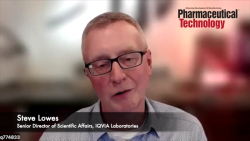
OR WAIT null SECS
- About Us
- Advertise
- Contact Us
- Editorial Info
- Editorial Advisory Board
- Do Not Sell My Personal Information
- Privacy Policy
- Terms and Conditions
© 2025 MJH Life Sciences™ , Pharmaceutical Technology - Pharma News and Development Insights. All rights reserved.
Understanding powder behaviour
The needs of the pharmaceutical industry for powder testing technologies are changing, primarily for two reasons. The first is that global economics, and the economics and competitiveness of the pharmaceutical industry itself, are driving manufacturers towards achieving greater efficiency.
The needs of the pharmaceutical industry for powder testing technologies are changing, primarily for two reasons. The first is that global economics, and the economics and competitiveness of the pharmaceutical industry itself, are driving manufacturers towards achieving greater efficiency. Success here demands a real understanding of all the factors at work in a manufacturing process. A second significant issue is the increasing sophistication and complexity of many of today’s, and certainly of emerging, pharmaceutical formulations dry powder inhalers being just one example. Demanding formulations designed to achieve highly effective and often specifically targeted, drug delivery present an array of new manufacturing challenges. As the manufacture of most pharmaceutical formulations involves powders at some stage, understanding how those powders will behave under specific conditions helps in making informed decisions about process design, development and optimisation.
One of the most important considerations is to be able to measure powders in a process relevant way. Manufacturers of powder testing systems have to appreciate the challenges that development scientists face, the complexity of powder processing and, most of all, how measurable powder properties relate to in-process behaviour. Over the years, a variety of pragmatic solutions have been established for testing powders. Manufacturers of modern powder testing equipment, such as the FT4 Powder Rheometer, have extended their application and added new, dynamic methodologies, bringing into one system a set of complementary techniques that together are able to better reflect a powder’s response to processing conditions.
What are the drawbacks of existing technologies?
An overemphasis on traditional techniques for powder testing has built a reliance on single number results, which give little real insight into powder behaviour, or the ability to predict how it may change under different conditions. Interpretation of what these results mean is often very much experience-based, few having the ‘black art’ required to convert measurements into predictions of processibility. Furthermore, although the terms associated with traditional testing techniques, such as angle of repose, are common parlance, they hide a significant degree of method variability, from company-to-company, site-to-site and even operator-to-operator.
As in many fields, developments in automation are helping to tackle the problem of variability, bringing significant advances towards better reproducibility. A well-defined analytical protocol, enshrined in an automation sequence, eliminates much of the variability associated with an analytical technique and makes it simple to transfer. Sample preparation is also the subject of greater attention in the search for enhanced reproducibility. As our understanding of powders has increased, it has become clear that the apparently changeable behaviour observed in processes is also an issue during analysis. Powder samples carry their history with them and their properties are influenced by an array of variables. A sample that has been vibrated and consolidated during transport and storage will exhibit very different properties from one extracted from a pneumatic conveyor and analysed immediately, even if the two are identical in terms of composition, particle size and particle shape. The latest analytical approaches increasingly recognise this and give sample preparation the attention it deserves.
And better reproducibility isn’t, of course, just a laudable aim it is essential to the sensitivity of a technique. If reproducibility is low then it is impossible to determine whether or not a given result is simply an artefact of the analysis or the sample. As technology advances and reproducibility improves, powder properties are becoming more clearly defined and the surrounding ‘noise’ has diminished, accelerating our ability to grow a real understanding of this industrially vital class of materials.
Where do we go from here?
We now have the tools to undertake the multi-faceted powder measurement needed to generate wide-ranging and process relevant information. Modern powder testers are highly sensitive, enabling the reproducible quantification of powders. As a result, we can finally construct databases that house reliable powder characterisation information. Such databases were not feasible in the past, so until now correlation of process and product behaviour with powder characteristics has been an empirical and extremely challenging task. With these data in place, industry has a real opportunity to rationalise performance in terms of robust parameters, thereby developing a much more secure knowledge base. Adopting this approach is entirely consistent with the current industry themes of QbD and PAT, and the drive towards greater manufacturing efficiency.
So perhaps the greatest advances in powder testing technology in the next decade will be the uptake of modern testing techniques and application of the very best data to transform the efficiency of powder processes. The potential here is enormous and the most far-reaching consequences of this are yet to be seen as the industry learns how to apply the information in the most effective way. The best powder testing companies are looking not only to their systems, but are also working with the pharmaceutical industry in promoting greater understanding of what the data mean for individual processes.


